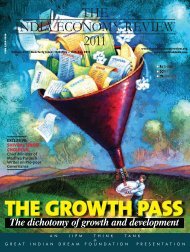Download - The India Economy Review
Download - The India Economy Review
Download - The India Economy Review
Create successful ePaper yourself
Turn your PDF publications into a flip-book with our unique Google optimized e-Paper software.
<strong>The</strong>re are several instances where people<br />
have strongly resisted the different moves<br />
of such mining companies. <strong>The</strong>y had re-<br />
sisted the land acquisition process, chal-<br />
lenged the environmental procedures, and<br />
expressed their strong discontented<br />
against any such action. In most of these<br />
areas PESA as a law had been abandoned<br />
by the offi cials thereby superseding it with<br />
other legal acclimation, while on the contrary<br />
people’s resistance had been turned<br />
into a law and order problem. In Scheduled<br />
Areas, it is seldom allowed to exercise<br />
their rights under the provisions of<br />
PESA.<br />
<strong>The</strong>refore in a general overview one<br />
could fi nd the depletion of natural resources<br />
like water, forests, land, declination<br />
of food grain produce and productive<br />
process, depletion in the arability of cultivable<br />
land, pollution of water, air and land<br />
and an alarming decline of democracy as<br />
an institution in these areas. Hence under<br />
these circumstances it is essential to look<br />
into the question of the professed national<br />
development through mining in the<br />
Adivasi areas vis-à-vis Adivasi development<br />
through local and natural resources.<br />
Never in the past, have the state and industry<br />
kept their promises with the ordinary<br />
people.<br />
Confl icts over mining have existed for<br />
more than four decades in different forms<br />
in. In earlier days such disagreements<br />
were not taken to be confl icts as such, but<br />
only as immediate questions related to<br />
inadequacy. Another reason for limitation<br />
of these confl icts is the limitation of trade<br />
union movements in industrialised areas<br />
to understand the gravity of the problem<br />
and address it thoroughly. <strong>The</strong> standpoints<br />
of trade unions were only one dimensional;<br />
related to an increment in<br />
wages or matters related with labouring<br />
class. <strong>The</strong> Union could never address the<br />
entire question of mining in totality.<br />
Moreover mining has been strongly presupposed<br />
as a major means of industrial<br />
development contributing to the state<br />
economy. Even organised trade unions<br />
fi nd nothing wrong in mining as such. So<br />
how the vehicle of development could be<br />
understood as a confl ict was another question.<br />
Over the course of time the very<br />
defi nition of state and its economy has<br />
changed. This has impacted the general<br />
thought process of the opinion building<br />
class.<br />
<strong>The</strong>se middle class thoughts have much<br />
refl ected in all the policy documents of the<br />
state. A few aspects are crystal clear fl ipping<br />
the mineral policy, the industrial<br />
policy, the investment policy, the environmental<br />
policy, the water policy, the land<br />
utilization policy and the compensation<br />
package. It is meant for increasing private<br />
and foreign capital in the mining sector by<br />
creating conducive business environment<br />
to attract private investment in the State.<br />
<strong>The</strong> state will provide counter guarantee<br />
in case of any loss incurred by such foreign<br />
companies. All social, political, environmental<br />
and legal hindrances have been<br />
slowly and strategically cleared for the<br />
entrance of these private sectors. For realising<br />
this, administrative procedures<br />
have been simplifi ed and all procedural<br />
impediments are taken care by the state.<br />
Now the Forests Conservation Act 1980is<br />
considered to be the biggest obstacles.<br />
Mining invariably brings about environmental<br />
destruction, human displacement<br />
R ESOURCE PLANNING<br />
and non repairable ecological imbalances.<br />
It undermines the amount of disparity it<br />
brings due to land acquisition. <strong>The</strong> indigenous<br />
people are denied of their eligible<br />
rights in mining zones and laws are fl outed<br />
by the State machinery. <strong>The</strong> rights of the<br />
mineworkers are also fl outed. <strong>The</strong> aftermaths<br />
of mining could be gazed in the<br />
following few points.<br />
<strong>The</strong> Final Word<br />
<strong>The</strong> picture is lucid that how the concept<br />
of industrialisation under planned development<br />
and now under globalisation<br />
liberalisation policies had adversely affected<br />
the masses. In this situation,<br />
where are the people going to be listed?<br />
<strong>The</strong> choice and space is limited. It is also<br />
clear that the land acquisition and free<br />
market economy goes hand in glove. In<br />
Never in the past, have the state<br />
and industry kept their promises<br />
with the ordinary people<br />
a market economy people are disallowed<br />
to exercise their free will at least in the<br />
matter of disposing their land at the<br />
market price. 72 <strong>The</strong> mechanism of compensation<br />
and rehabilitation is too much<br />
supportive to the corporate sector; this<br />
only pauperises the poor than a change<br />
in their destiny. <strong>The</strong> principles of compensation<br />
often forgets or never estimates<br />
that on the very fi rst day of reaching<br />
a rehabilitation colony, a poor<br />
family has to buy fi rewood, which they<br />
procured free from the Common Property<br />
Rights (CPR). 73<br />
Land is a productive asset but people<br />
are more emotionally attached with the<br />
land in many ways. For many it is the symbol<br />
of their freedom. To some it is the<br />
THE INDIA ECONOMY REVIEW<br />
159





